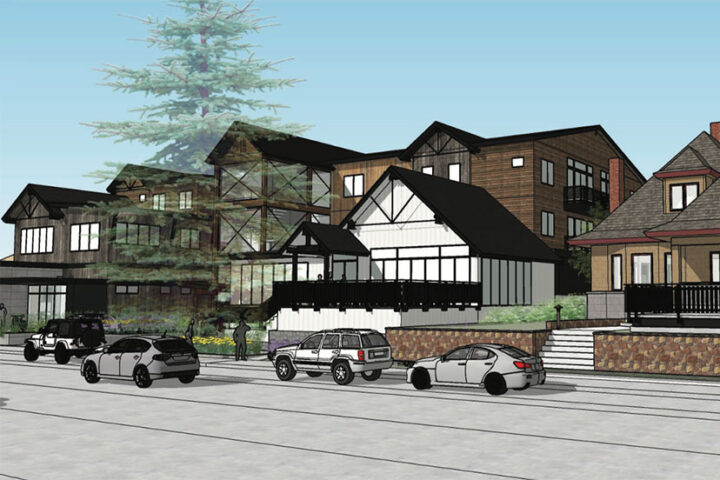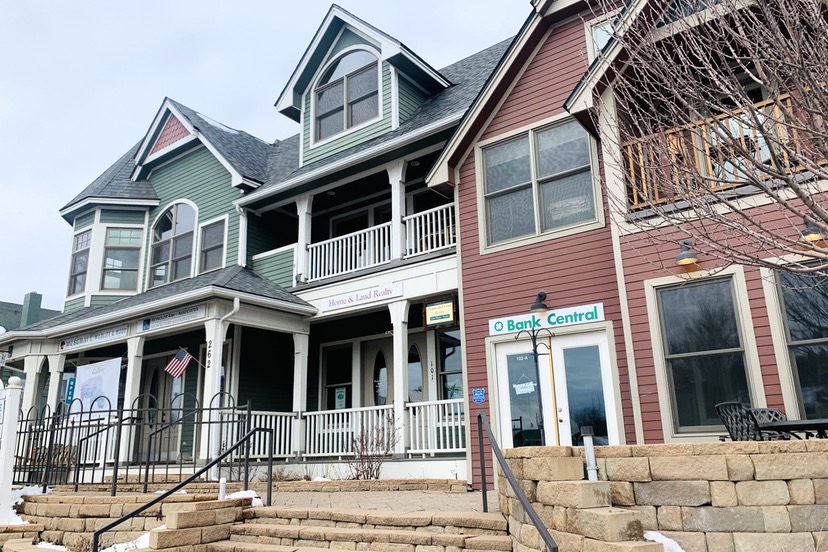Photo: The Town Terrace mixed-use complex in the East Village is one of the few new buildings constructed in downtown Pagosa, following the adoption of the ‘Downtown Master Plan’.
The Downtown Master Plan is the product of a collaborative effort among many citizens who seek to ensure that the downtown is vibrant and thriving for future generations…
— from the Town of Pagosa Springs Downtown Master Plan
Back in 2007, the Town of Pagosa Springs adopted a long-range, 135-page plan for its downtown. The plan (which you can download here) aimed to preserve certain architectural characteristics of the existing physical design by, basically, limiting what future developers would be allowed to build, and by encouraging certain development patterns.
In the neighborhood known as the ‘East Village’, for example, the plan called for a more ‘residential’ type development pattern, with smaller buildings no more than two stories high.
Not much happened in the East Village between 2007 and 2024, architecturally speaking, other than the demolition of several buildings, and the construction of the Town Terrace complex.

Then, in 2022, developers Brad Ash and Marty Rose came to the Town with a plan for a massive three-story structure in the midst of the East Village.
From my reading of the Downtown Master Plan, this building did not meet the intentions for the East Village as written in the 2007 plan.
But the project was approved nevertheless.

It’s the type of thing that can make you wonder about the value of local government plans.
This editorial series was inspired by the decision, by the current Archuleta Board of County Commissioners, to hire a remote consulting team — Civic* Possible — to develop a ‘strategic plan’ for the County.
I’ve been making the argument that what is truly important, when strategically planning for an uncertain future, is not “the plan” but “the planning process”. And in my view, “the planning process” is best carried out by the people most intimately involved in making future decisions — not by people from distant cities who have no lived experience in Archuleta County.
Nevertheless, here we are. Our elected commissioners are doing exactly what I wish they weren’t doing.
Not for the first time, nor will it be the last.
“Plans are worthless, but planning is everything…” In an emergency, the first thing to do is “to take all the plans off the top shelf and throw them out the window…”
— from an article about President Dwight Eisenhower in The New York Times, 1957.
Apparently, the Civic* Possible team is working hard to understand who we are, here in Archuleta County, and what we care most about. To that end, you can participate in this process by responding to an online survey.
Presumably, if you participate in this survey, it means you care about Archuleta County, in some fashion. Perhaps you have a vision for the community’s future. Maybe you’re part of an organization or group that is trying to help define that future.
I found the survey to be perfunctory, and — as with most online surveys — lacking in opportunities for meaningful input. No doubt it will result in some colorful pie charts.
I mentioned, in Part Three, a couple of local strategic plans that were created by local citizens, without extensive use of outside consultants: a plan for Pagosa Peak Open School, and a plan for the San Juan Water Conservancy District. That is to say, in both cases, the process was guided by, and carried out by, the very people most concerned about the plan.
But there’s curious thing about strategic plans, and representative government. I’m talking about changes in leadership. Only one person involved in writing the 2021 Strategic Plan for SJWCD remains on the SJWCD Board. None of the other current Board members participated in the research and writing of the organization’s strategic plan.
Almost all the people who participated deeply in creating the plan have moved on.
The same can be said about the plan written in 2016 for Pagosa Peak Open School. Only one current Board member was involved in that process. (The PPOS Board has begun work on an updated strategic plan, however.)
So we have this curious situation. While a plan may sit on a shelf for years, the people in local leadership tend to come and go.
Not always, of course. The Town of Pagosa Springs had the same mayor — Ross Aragon — for 32 years. In the case of our Board of County Commissioners, state law limits each commissioner to two consecutive terms in office — so, a limit of eight years, maximum. Perhaps that’s why the BOCC press release about the current strategic planning process mentioned a time limit?
The “next three years”?
This important initiative aims to set the direction for the county’s future over the next three years, ensuring that our growth and development reflect the values and needs of our community.
As readers of this editorial series have no doubt realized by now, I’m skeptical of a planning process guided by consultants who do not live in Archuleta County. I’ve watched too many plans sit around, collecting dust… ignored by future leaders who have their own personalized agendas, and who didn’t participate in creating the plan.
But at least the County has low expectations for this project, if it’s indeed intended to address our community’s needs for only three years.
The first year is already half done…

